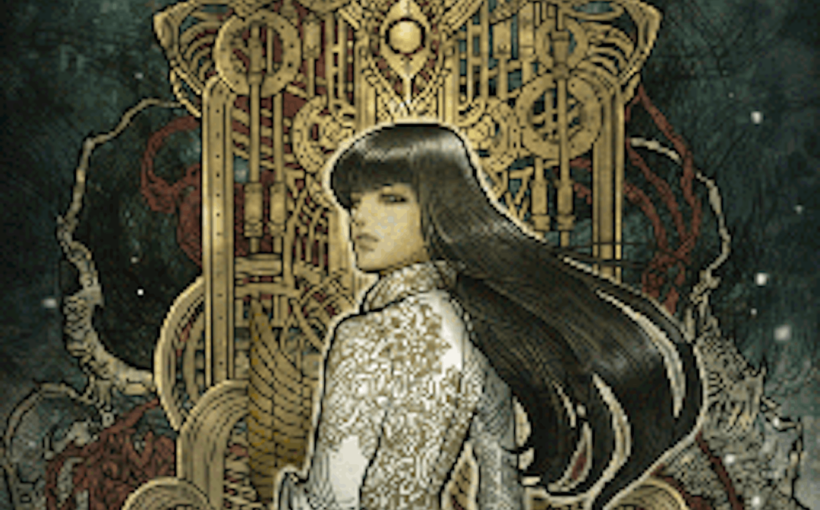The Umbrella Academy is the story of seven adopted superhuman misfits and their super-rich father, Sir Reginald Hargreeves (AKA the Monocle). If you have watched the television adaptation, which is barrelling into its last season, you will already be fans of the mix of conspiracy, US ephemera and choreographed ultraviolence as well as the more domestic aspects of a long-form drama.
The comics, written by Gerard Way (yes, of My Chemical Romance) and illustrated by Gabriel Bá, work slightly differently and are a pastiche of literary influences. It is a rethinking of the stories of Children of the Atom by Wilmar Shiras (1953), which follows a group of children with superhuman intelligence, seen through a lens of DC’s Doom Patrol (1963-2023) comics about a group of superpowered misfits who were experiments and accidents, and classic Hanna-Barbera cartoons.
The comics are visually arresting with strong, often calligraphic linework, and a sardonic wit. They contain sparing instances of extreme gore rather than television’s slick action, along with media-conscious wit to skewer contemporary society.
With the final season here of the Netflix adaptation, and while fans of the comic eagerly wait Volume 4: Sparrow Academy, here are five recommendations that fans of this weird world will likely also love:
1. Monstress (2018, Image comics) by Marjorie Liu and Sana Takeda
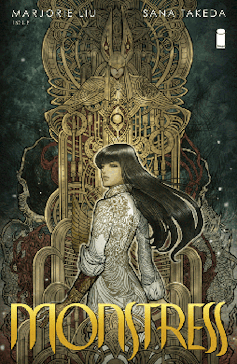
Maika Half-Wolf is a young woman determined to avenge her mother and her people in a world where humans use her kind to fuel their magic. The worldbuilding in this comic series is astounding. The first book opens up weirder and more interesting aspects of this world with every page and explores dark and strange elements of its lore.
An eclectic mix of steam, clockwork, atom and magic technologies are well managed in Monstress by Sana Takeda. By contrast, The Umbrella Academy’s world of steam and atompunk is beautifully captured in Bá’s artwork, but is underplayed visually in the TV show. In Monstress, these themes are expanded thoroughly in a series that has political intrigue and intricate characterisation which is beautifully drawn and narratively complex.
2. Saga (2012, Image Comics) by Brian K. Vaughan and Fiona Staples
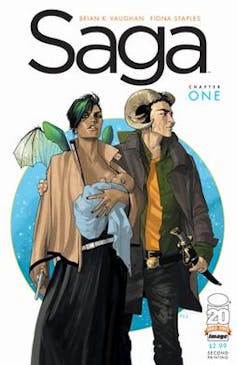
Saga is the story of Hazel, a child born to parents who have deserted opposing sides of a bitter intergalactic war ravaging every planet. The new family’s small act of love and defiance in the middle of a war zone has huge consequences that reverberate across both of the warring empires.
This is an epic story from Brian K. Vaughan and Fiona Staples, that manages to make the hard lives of a few refugees from a colossal intergalactic war familiar and relevant. It is a sprawling space opera with frequently fantastical action sequences and spectacular fights but also interpersonal intrigue, familial drama and serialised storytelling that is refreshingly compelling and satisfying. It also managed to outlast and overcome calls to ban it when it was released because of its sex scenes and LGBTQ+ themes. Consequently, it remains one of the most interesting and robust stories on this list.
3. Something is Killing the Children (2019, Boom Comics) by James Tynion IV and Werther Dell’Edera
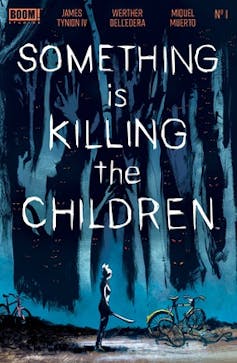
This comic strikes an interesting balance between horror and slow thriller. In a small, grey Wisconsin town, children have been going missing. Most never return, but the ones that do tell horrific stories of terrifying creatures.
Unable to stop the grisly deaths and unwilling to understand the bizarre occurrences plaguing them, the townsfolk turn reluctantly to a young woman, Erica, who has strange eyes and likes cheap chainsaws “that will just keep going” even if they hit bone. The story follows Erica as she hunts and defends the paranoid townsfolk who have no conception of themselves as prey for unspeakable things.
Something is Killing the Children is frequently disturbing, with a main cast of characters that you really root for. It is an intriguing contemporary take on American gothic that contains unfolding conspiracies, haunted pasts and woods that are creepy, dark and deep.
4. Transmetropolitan (1997, Dark Horse Books) by Warren Ellis and Darick Robinson
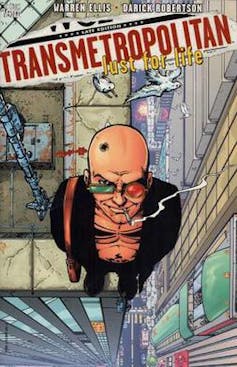
Spider Jerusalem is a tattooed, misanthropic political correspondent – a man who would very much like to not be part of society, but finds himself the only person able to actually see it for what it is.
He returns to the city from a self-imposed exile to write once again for the Word, a newspaper who will pay him enough to have full journalist insurance (a carte blanche to do whatever he likes in the name of truth), an unlimited television and computer feed (so he can absorb all media without break), and a constant supply of intelligence-enhancing drugs.
Transmetropolitan was outrageous, satirical rage-filled punk for the 90s and many aspects have aged badly (the gender and body politics may cause wincing). But it is also horrifically prescient in some aspects, foreshadowing the rise of political populism as well as corporate and media saturation. It remains visually loud, searingly witty and often depressingly truthful.
5. The Filth (2004, Vertigo) by Grant Morrison and Chris Weston
Scottish comics author Grant Morrison is renowned for some of the most exciting revivals and stories across mainstream comics over the last few decades. This includes DC’s Doom Patrol, which Umbrella Academy’s writer Gerard Way cites as an influence and also ended up working on.
Morrison and Weston’s The Filth is a bizarre book following Ned Slade: super-agent, wearer of a psychotropic toupée and perhaps also a porn addict called Greg Feely in a parallel life. Slade, as lead agent of a group of super-secret police known as the Hand, hunts for a rogue agent threatening to knock reality from its “Status Q”.
Like Umbrella Academy, it is a knowing postmodern comic full of world-breaking conspiracy, bizarre villains and weird science fiction. But it’s also an unfettered exploration of psychological dysfunctionality and a rotten body politic.

Looking for something good? Cut through the noise with a carefully curated selection of the latest releases, live events and exhibitions, straight to your inbox every fortnight, on Fridays. Sign up here.
![]()
Geraint D'Arcy does not work for, consult, own shares in or receive funding from any company or organisation that would benefit from this article, and has disclosed no relevant affiliations beyond their academic appointment.
